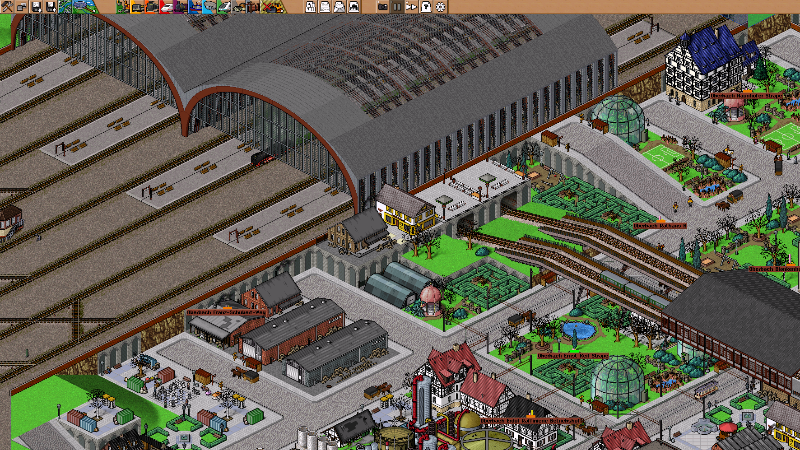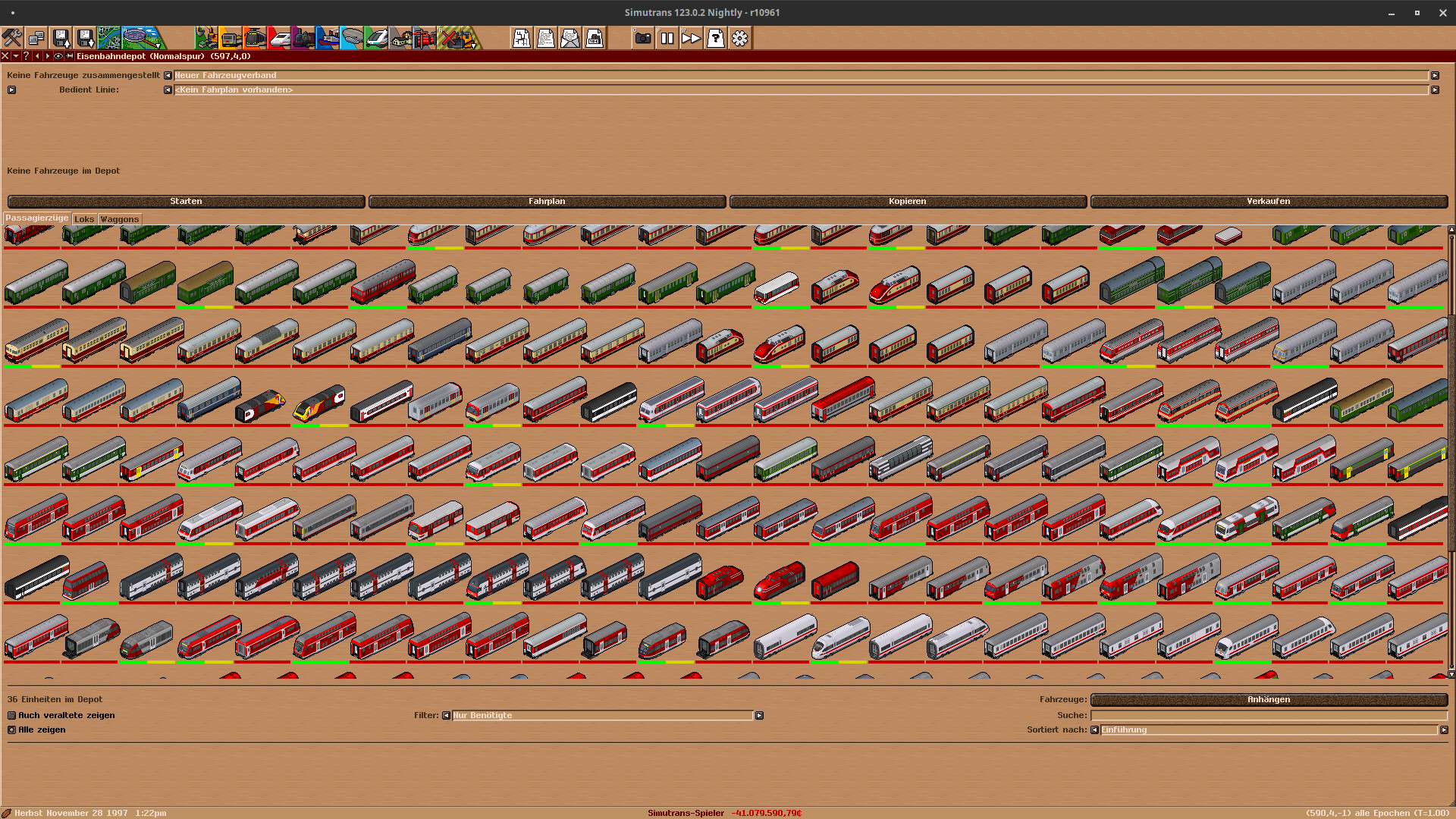The Pak192.Comic recently released version 0.7 of this comic themed pakset. If you are playing Simutrans on Steam and you installed the Pak192.Comic DLC, you will get the update automatically. Otherwise, please see “Where and what to download” section.

Changelog
Gameplay changes
- turned “avoid over overcrowding” off by default again
- , and . now work for controlling time in the game
- ( and ) now work for sliced view up/down
- road speeds from 50 to 55 and from 70 to 80
- pricing that considers the actual build year of the vehicle, instead of the introduction year
- Pubs now comsume rum as well
- there is a track/track submenu now
- increased the productivity of the wiredrawer
- higher fix costs for ships
- changed to intro years of 120 and 160 kph track
- tutorial works with the tutorial button now
- playing from 1930 onwoards should feel way more complete now compared to previous versions
New objects
Industry
- European sugar production with beets (farm, fields, refinery)
- biofuel plant
- Additional coal power plant that better fits early years
Infrastructure
- river stop for goods
- letter box stop for road
- docks for pax
- older post office
- track with different kinds of gravel beds
- 1850 station hall
- steel girder bridge for narrowgauge
- HUGE HUGE station hall for people that need to prove they have the biggest network
- narrowgauge tunnel for 50km/h
- 80kph railway bridge
- streetlights as (free) wayobj
- fake city road in cobblestone look
- Lot of new SBB Type N and L Signals
Buildings
- citybuilding “Danivision”
- citybuilding “Keycaps Skyscraper”
- citybuilding “Taipei 101”
- monument “Disco Sphere”
- curiosity “StarGate”
- curiosity “Guardhouse”
- inverse Corner for St. Pölten station building
- alternate version of all Pölten elements
- several new citybuildings across all climates
Vehicles
- more ships for channels
- gigaliner converter for semitrucks
- HHA DT6
- Baden IVh
- a couple of Baden express coaches
- old Baden compartment coaches
- lots of old freigth cars and hoppers
- Baden VIc
- old AC S-Bahn Hamburg
- DRG D21b / C21 Abteiwagen
- DRG “Donnerbüchse”
- DR Rekowagen
- DRG E01
- KPeV EG502
- KPeV EG511
- KPeV ES1
- Getreideschiff
- old postal tram
- prussian G12
- ET 88
- ET 41
Things that walk around
- various new generic pedestrians
- try to spot some easteregg-pedestrians too
- ducks, swans, sharks and a whale
- a fox
Improved objects
- the narrowgauge to road crossings
- some sounds for some trains (not too many yet sadly)
- swapped the first and second player colour for green coaches
- various glitch fixes
- palyer colour for the Alsterdampfers
- player colour for V200
- SBB EW I
- the old track plattforms
- updated DRG coaches
- loading image for beets for many vehicles
- crossing track narrowgauge now fits the whole tile
- SBB PTT
- player colour for bavarian D VIII
- ET 11
Addons
In plus to the “core” Pakset, there are multiple changes to the addons provided within the repository:

New version of the game: The all DACH pakset contains the main pakset and the DACH addons.
Vehicles
- BR 216 “Lollo”
- 4 car OBB Cityjet for Vorarlberg
- Bpm 61 20-70
- SBB Bpm 20-90
- SBB EW IV
- BT EW IV
- orientrote BR 218
- updated Nuremberg subway cars
- new SNCB I6 livery
- update gear values for most british vehicles so they can reach their top speed
- SNCB HLE 17
- SBB IC2000 postal car
- DB Mintling coaches
- fictional BR 427
- BR 423 and BR 430 for BWegt
- BR 422 for VRR
- BR 426 for BOB
- BR 425 for Transdev
- 120km/h Silberling
- more colours for the BR 110, 110.12, 110.3, 111, 112, 113, 140, 141, 150, 151…
- HHA AL
- EMT CLASS 156
- two RZD sleepers
- FLIRT 1 for SBB
- FLIRT 3 for BWegt and SBB
- extra livery for DSB EG
- player colour for class 59, 92, 375, 376, IC225
- 140kph/h TEE VT11.5
- sleeper 61-7034
- update of the docklands units to jakops boogies
- more colours for BR 18.3, 58.2, 75.4
- Wittenberger Kopf
- German luggage cars as empty and piece good cars
- more “preußische Abteilwagen”
- prussian luggage car PWIRP91
- RABe512
- CIWL Lx20
- express coach Bauart 1935
Infrastructure
- tunnel catenary for standard gauge
- side swapped catenary
- infty Tunnel
- vmin = 121 and vmin = 71 signs
- track with different kinds of walls
- infty bridge for track
- two extra platforms based on the 1850 platform
- station hall 1890 in 3 parts as well as an inversed version
- brick build depot
- 1850 station hall in bright colours
Where and what to download
- The Pakset for Simutrans: pak192-comic.zip
- The Addons for the Pakset for Simutrans: pak192-addons.zip
- The combined file containing the Pakset and the Addons for the Pakset for Simutrans: pak192.comic-serverset.zip
- The combined file containing the Pakset and the DACH-region only Addons for the Pakset for Simutrans: pak192.comic-all-DACH.zip
- The Themes: themes.zip
What’s missing still?
- There are only 3 climates actively developed so far, those are Western, Continental and Alpine (temperate, tundra, rocky) other climates are lacking in city development. If you got cities in those climates, you might want to use the climate tools as public player to switch to a more developed climate. Most factories are not affected.
- Translations! The German translation now seems pretty complete, while the English translation is still ongoing. And don’t mention anything else…
- Ships, ships and even more ships.
- Not every mode is able to transport every good at any given time. Best bet is that there is a narrowgauge option for it, second are rail and trucks.
Contribute?!
Feedback always is appreciated!
Please tell us what you like, dislike and would want to have improved!
In plus, freely contributing to the pakset is a thing! Pak192.Comic is open source, freely adjustable and auto compiles from github actions. That means, you could just clone the repository, do some funky changes and have github build your very own version without doing a lot for it. There’s no weird encoding, no encrypted values, nothing. If you go to the dat file for your favourite steam engine and change the maximum speed from 100 to 2000, you just did that. It’ll appear in the game just like that. Don’t like coal power stations? Just get rid of them. Want to have a rainbow coloured subway? Just draw a rainbow on the image of your favourite subway train. That’s pretty cool, right? But how about you share your funky changes with the rest of the world by adding them to this repository once they work out just fine. That way you could improve the world!… or well, at least this game.
Link to the GitHub: https://github.com/Flemmbrav/Pak192.Comic
In Plus, there’s a lot of stuff to translate. In case you can speak a langauge in plus of German, you’re a perfect match for this!
In case you need help modifiing or contributing towateds the game, do not hesitate to ask for some.
















